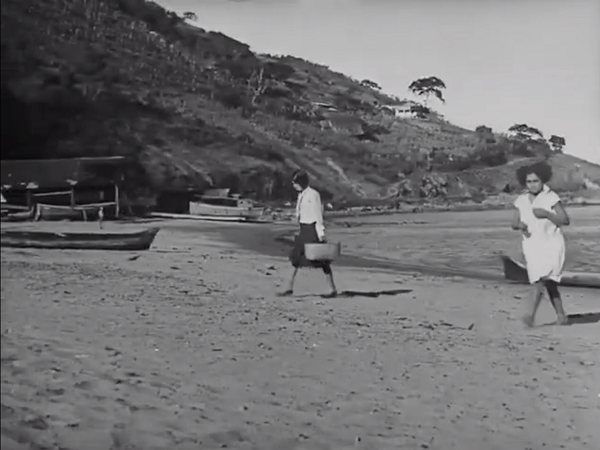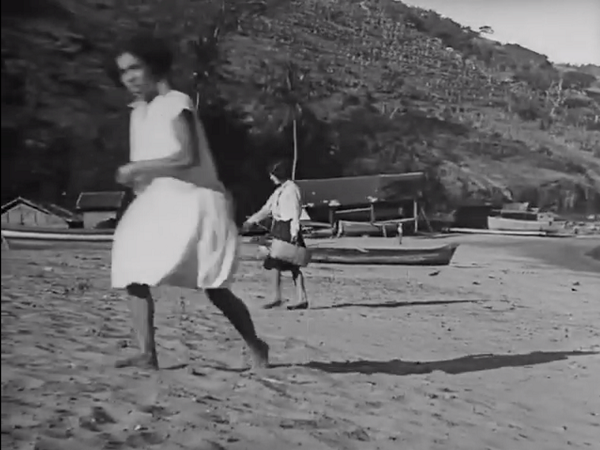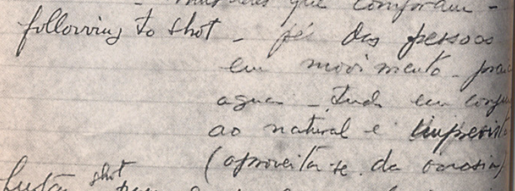Essay
Limite and the Image We don’t See:
A Critical proposal
By André Keiji Kunigami
The fact is that both in Glauber Rocha’s critique, who defined Limite as “entirely removed from reality and history” – that is, too “universal” – and in the repeated praise for aesthetics that “doesn’t let you see that it was made in Brazil,” as Otávio de Faria wrote in an article of May 10, 1931 in A Pátria, the paradigm of the need for fair national representation reveals a projected desire on cinema and on the modern nation [2]. Whether as the manifestation of the cosmopolitanism of the local elite contained in the desire for a universality that would avoid the Brazilian “embarrassment” against modern northern nations, as described by Faria, or in the rejection of this same cosmopolitanism in favor of revealing the ills of underdevelopment, the notion that Limite emerges from the individual genius of Mário Peixoto, as an enigma outside history, prevails in the mythology surrounding the film. In addition to the colonial dichotomy that underlies the false dualism between universal and particular, the problem with this construction of the film as an exceptional object, the result of the genius of an individual ahead of its time, is its interdictory character: one cannot speak, except in the terms of the author himself. This same faith in the genius Peixoto left an essential legacy by guaranteeing the film’s preservation for decades. However, the more it is exceptionalized, the more distant a cultural artifact becomes.
Everything around Limite, an unquestionable landmark of silent Brazilian and Latin American cinema, is superlative. It can be said that the discourse that prevails until this day about the film echoes the critical essay signed by Otávio de Faria mentioned above: a compliment to the immersive experience of its film architecture, which would give Brazilian cinema a universality and modernity inexplicable for the national context of your time. It is, therefore, also about the film materialization of the antinomies of our modernity/coloniality. After all, as Otávio de Faria – Peixoto’s friend and greatest interlocutor – demonstrates himself one of the great consequences of Limite’s film exceptionality would have been the proof, in contrast to the film’s universality, that “we are so much more delayed in cinema than in the rest” [3]. As we revisit the CD-ROM organized by the Laboratório de Investigação Audiovisual [Audiovisual Investigation Laboratory] of Universidade Federal Fluminense in 1998 and celebrate Limite’s legacy, I propose that it is necessary to focus on the sediments that constitute it as an amalgam-object of certain Brazilian modernity. Perhaps this is the key critical gesture for a decolonial and attentive understanding of the historical materiality of our most valuable cultural artifacts: repositioning and detaching in discourses, projects, and scales. If, in the scope of world cinema historiography – notoriously Eurocentric, even today – Limite is a rarer presence than one would expect, could we say that universality is in the eyes of the beholder? Or, in other words, that the colonial paradigm necessarily always imposes itself on Brazilian cinema? I suggest that such questions are wrong. And that Mário Peixoto’s film is, rather, a precious repository of disputed ontologies that translate into film form the aporias inherent to Brazilian modernity/coloniality.


Here above I post two images that flash on the screen for a fraction of a second in Limite. Taciana Rei (or the character “woman 2”) carries the fish she has just bought from a group of fishermen. Rei crosses the beach on the sand, tracing a path along the midline of the image, which leads the camera in a smooth movement that keeps her in the center of the frame throughout the length of the shot. However, an unexpected intervention interrupts the plan’s geometry: a young, black and barefoot woman crosses the frame in a line that is not the same as that drawn by Rei. Her sudden appearance, which increases in scale as she approaches the camera, instantly displaces Taciana Rei into the background. She walks towards the camera. As soon as she enters the frame, her gaze moves furtively towards the camera. She continues her journey and, just before returning to the invisibility of the out-of-frame, once again looks at us. Her passage is quick, and her two gazes are barely noticeable – but fundamental.
I direct the focus to this plan because it is an apparent anomaly within the architecture so painstakingly constructed by Mário Peixoto. It is important to remember what this architecture of Limite is about, what its pillars are: a formalism generated in the readings of French theory, in the astonishment of Jean Epstein’s photogeny, in the dialogues of Mário Peixoto with Otávio de Faria. Limite, in its sensory intimacy, is also a monument to an ontology of cinema as a universalizing experience through silent visual purity, the disembodied enjoyment of duration, and the exploration of the metaphysical capacities of rhythm and film plane – as vehemently defended by Otávio de Faria and the Chaplin Club group. In short, the modernity contained in the thesis of the universality of form.
In this aesthetic building, the brief spectral presence of this young black woman who cuts through the plane is obvious. In the script for the film, it reads: “[70]. following to shot: people’s feet on the move – beach – water – all together with the natural and unexpected – (take advantage of the occasion)”. (Image 3) “Take advantage of the occasion,” wrote Mário Peixoto, in parentheses. With all the other actions well described, in a script designed for maximum control and predictability of the image – in dialogue with Otávio de Faria’s script theory -, it can be said that the inclusion of the young black woman and her look towards to us (the only black presence that even occupies a frame in the film) happened by chance due to the minimal opening, of five words, contained in the script: “take advantage of the occasion”. The appearance of the young woman, who is not named, was the result of a planned accident.

Extracted from Limite: Scenário Original.
Rio de Janeiro: Sete Letras / Mário Peixoto Archive, 1996, p. 56.
This glimpse of the intrusive presence of this unnamed young black woman, who emerges from an incorporated chance and then becomes invisible – obliterated – as the historical sediments constitute the exceptionality of the myth, is what shows Limite’s power in the impurity of form, through the film’s capacity to be this amalgamation of Brazilian modernity as a film form. By leaving in the final cut the intrusion of what evidences the “other” to his system, Mário Peixoto seems to have left the key to suspicion as central to his aesthetic project. Limite reveals the repressed difference as a spectrum. In this reading against what I propose, this spectrum is capable of revealing that an accident of visibility is, in reality, the very definition of the universality of the form as unstable. A flash that calls into question what it illuminates. If Roberto Schwartz described Brazilian modernity as a regime of ideas “out of place”, Limite shows us that the outside is the condition for the possibility of what is inside. I believe that it is from this understanding that new critical readings can emerge, committed to a decolonial displacement: the understanding of Limite as a rich and complex aesthetic archive of historical desires capable of revealing the intrinsic relationship between film form, ontologies, and our modernity/coloniality.
[ 1 ] See: Glauber Rocha. “O mito Limite. “Revisão Crítica do Cinema Brasileiro. São Paulo: Cosac & Naify, 2003, 57 – 67; Mário Peixoto, “Um filme da América do Sul,” Escritos sobre cinema . Rio de Janeiro: Aeroplano, 2000. 84 – 94.
[ 2 ] Glauber Rocha, “O mito Limite”, p. 59. Otávio de Faria, “Limite,” A Pátria , May 10, 1932, pp. 1 and 4.
[ 3 ] Otávio de Faria, “Limite,” A Pátria , May 10, 1932, p. 1.
